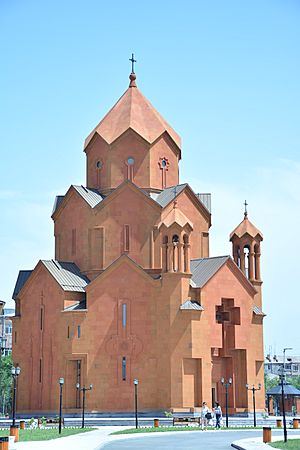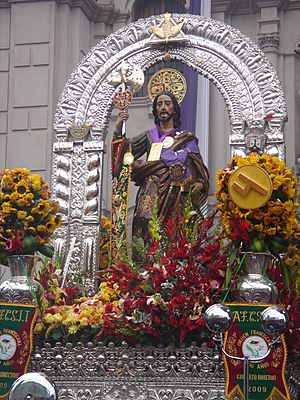Jude the Apostle facts for kids
Quick facts for kids SaintJude the Apostle |
|
|---|---|
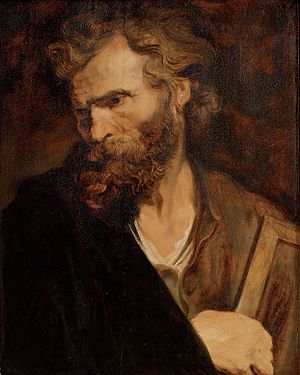
The Apostle Judas Thaddeus by Anthony van Dyck
|
|
| Apostle and Martyr | |
| Born | 1st century AD Galilee, Judea |
| Died | c. AD 65 |
| Venerated in | All Christian denominations that venerate saints |
| Canonized | Pre-Congregation |
| Major shrine | St. Thaddeus Armenian Monastery, northern Iran; St. Peter's Basilica, Rome; Reims, Toulouse, France |
| Feast | 28 October (Western Christianity) 19 June and 30 June, (Eastern Christianity) |
| Attributes | Axe, club, canon, medallion |
| Patronage | Armenia; lost causes; desperate situations; hospitals; St. Petersburg, Florida; Cotta; the Chicago Police Department; Clube de Regatas do Flamengo (in Rio de Janeiro, Brazil); places in the Philippines (Lucena in Quezon, Sibalom in Antique, and Trece Martires in Cavite); and Sinajana (in Guam) |
Jude was one of the Twelve Apostles of Jesus. He is often called Thaddeus or Jude Thaddaeus. It's important not to confuse him with Judas Iscariot, who was the disciple who betrayed Jesus.
Jude is a patron saint for people in desperate situations or who have lost causes. The Armenian Apostolic Church also honors him as one of its patron saints.
You can often spot Jude in pictures because he is shown with a club. This is a symbol of how he died. Sometimes, he has a flame around his head. This flame reminds us of Pentecost, when he received the Holy Spirit with the other apostles. He might also be holding an image of Jesus, known as the Image of Edessa. Other times, he holds a scroll (representing the Epistle of Jude) or a carpenter's rule.
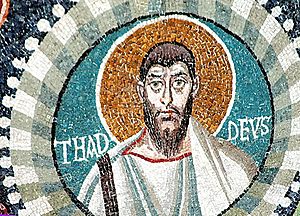
Contents
Who was Jude the Apostle?
Jude in the New Testament
Jude is clearly different from Judas Iscariot, another apostle who betrayed Jesus. Both names, Jude and Judas, come from the same Greek word, Ioudas. This name was very common among Jewish people back then. In many languages other than English and French, Jude and Judas are called by the same name.
The New Testament mentions Jude or Judas in a few ways:
- "Jude of James," one of the twelve apostles.
- "Judas, (not Judas Iscariot)," who was also an apostle.
- The brother of Jesus.
- The writer of the Epistle of Jude, who calls himself "the brother of James."
Many people believe that the first two points refer to the same person.
Was he a brother or son of James?
When the Bible was translated from its original Greek, there were different ways to understand "Jude of James." Some translations say "Jude, brother of James." This would mean he is the same person who wrote the Epistle of Jude.
However, most modern translations say "Jude the son of James." This means he would not be the same person who wrote the letter. Scholars often think "son" is more likely because the Greek word for "brother" is usually included if that's what is meant.
Jude and Thaddeus
In some lists of the apostles in the Bible, Jude's name is missing. Instead, a name like Thaddeus appears. This has led many Christians to believe that Jude and Thaddeus are the same person, often called "Jude Thaddeus." It was common for people in those times to have more than one name.
Some think that the name "Judas" became unpopular because of Judas Iscariot. So, people might have used "Thaddeus" to avoid confusion.
The Golden Legend, a collection of saint stories from the 13th century, says that Jude had many names. It explains that Thaddeus means "taking a prince" or "royal vesture of God." It also says he was called Lebbaeus, meaning "heart" or "worshipper of heart."
Stories and Traditions
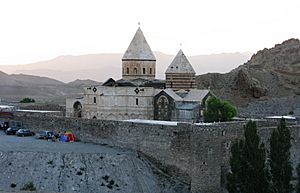
Tradition says that Jude traveled to many places to share the Gospel, including Judea, Samaria, Syria, and Mesopotamia. He is also believed to have visited Beirut and Edessa. Some stories even say Jude was the bridegroom at the famous wedding at Cana, where Jesus turned water into wine.
Jude was born into a Jewish family in a town called Paneas in Galilee. Like most people in that area, he probably spoke both Greek and Aramaic. He was a farmer. According to tradition, Jude's parents were Clopas and Mary of Clopas, who was a sister of the Virgin Mary.
Even though Saint Gregory the Illuminator is known for bringing Christianity to Armenia, it is believed that Jude and Bartholomew were the first to introduce the faith there. Because of this, they are honored as the patron saints of the Armenian Apostolic Church. The Saint Thaddeus Monastery in Iran and the Saint Bartholomew Monastery in Turkey are linked to this tradition.
In 2015, a new Saint Thaddeus Church was built and blessed in Masis, Armenia.
Death and Resting Place
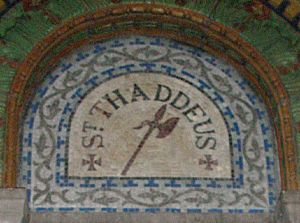
Tradition tells us that Jude became a martyr around 65 AD in Beirut, which was part of the Roman province of Syria. He died alongside another apostle, Simon the Zealot. The axe that you often see him holding in pictures shows how he was killed.
Many people believe that Jude's body was brought to Rome. His bones are now in a crypt in St. Peter's Basilica, in the same tomb as the remains of Simon the Zealot. Many visitors come to this spot to pray.
Centuries ago, an arm bone was taken from St. Jude's remains. It was placed in a special wooden container shaped like an arm giving a blessing. From September 2023 to May 2024, this arm relic traveled to 100 cities in the United States for people to see and pray near.
What Jude looks like in art
Jude is often shown holding an image of Jesus or having it close to his chest. This refers to the story of the Image of Edessa. In this story, King Abgar of Edessa sent a letter to Jesus, asking for healing. He also sent an artist to paint Jesus. Jesus then pressed his face into a cloth, creating an image, and gave it to the artist to take back to the king. Later, the apostle Addai (who some identify with Jude Thaddeus) visited King Abgar, and the king was cured and became a Christian.
Jude is also often shown with a flame above his head. This represents his presence at Pentecost, when he received the Holy Spirit along with the other apostles.
Honoring Saint Jude
After his death, people began to visit Jude's grave to pray. Many reported that their prayers were answered, especially in very difficult situations. This is why he became known as 'The Saint for the Hopeless and the Despaired'. Some saints, like Bridget of Sweden, even had visions telling them to accept St. Jude as 'The Patron Saint of the Impossible'.
His special day, or feast day, is October 28 in the Roman Catholic Church, Anglican Communion, and Lutheran Church. In the Eastern Orthodox Church, he is remembered on June 19 and June 30.
Devotion to Saint Jude became very popular in the 19th century, starting in Italy and Spain. It then spread to South America and the United States.
Patronage of Saint Jude
Among some Roman Catholics, Jude is honored as the "patron saint of hopeless causes." This belief might come from the idea that people were afraid to pray to him because his name was similar to Judas Iscariot. So, the story goes, the ignored Jude was very eager to help anyone who asked him, even in the most desperate situations.
Jude is also the patron saint of the Chicago Police Department and of Customs Officers. He is also the patron saint of the Clube de Regatas do Flamengo, a soccer team in Brazil. His other patronages include hospitals. One famous place named after him is St. Jude Children's Research Hospital in Memphis, Tennessee. This hospital has helped many children with serious illnesses since it opened in 1962.
Shrines and Churches
Many countries have built shrines or churches to honor Jude the Apostle. These include places in Australia, Brazil, India, the Philippines, the United States, and Lebanon.
- The National Shrine of St. Jude in Chicago, Illinois, was started in 1929.
- The National Shrine of Saint Jude Thaddeus in the Philippines was built in 1954. It holds a special prayer service every Thursday.
- The National Shrine of Saint Jude at Faversham in England was founded in 1955.
- There is also a shrine of St. Jude in Lagos, Nigeria.
The main church for the Roman Catholic Diocese of Phoenix, Arizona, is the Cathedral of Saints Simon and Jude.
Jude in Islam
The Quran, the holy book of Islam, talks about the disciples of Jesus. It doesn't give their names or numbers. However, Muslim scholars generally agree with the New Testament list of disciples. They believe the disciples included Peter, Philip, Thomas, Bartholomew, Matthew, Andrew, James, Jude, John, and Simon the Zealot.
See also
 In Spanish: Judas Tadeo para niños
In Spanish: Judas Tadeo para niños
- Judas the Zealot
- Statue of Jude the Apostle, Charles Bridge
- Veneration of Judas Thaddaeus (San Judas Tadeo) in Mexico



